Pete’s Gear: VOX U.S. Thomas Organ ‘Super Beatle’ amplifiers
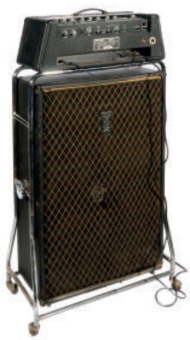
News (May 2010): Christie’s auctioned Vox Beatle Super Stack, as part of its Popular Culture: Rock and Pop Memorabilia sale, on 24 June 2010. The amplifier is currently owned by Brad Rodgers of whocollection.com.
Rock Stars Guitars for sale at Christie’s
A 1960s ‘Vox Beatle Super Stack’, comprising — a Vox Beatle amplifier, model V1143, serial number 1290020 and a Vox Beatle Speaker Cabinet, model V4141, serial number 195274, the cabinet stencilled on the back in white block lettering THE WHO — used by The Who on their US tour, 1967, overall measurements — 28½×57in. (75×145cm.)
£800–1,000 (US$1,200–1,500; €900–1,100)
Realized: £2,250 ($3,366)
See christies.com for lot details.
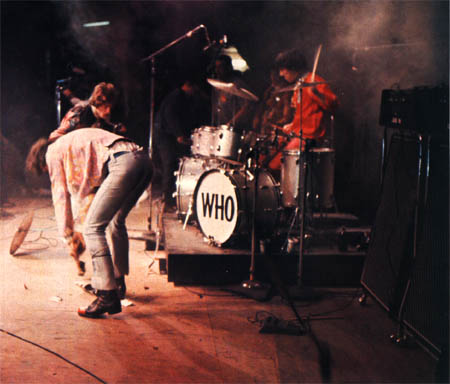
June 1967, Monterey Pop, showing two Super Beatles, with tops reversed on the chrome roller rack. Pedal is a Marshal Supa Fuzz.
For the Who’s first shows and tours of the USA in 1967, instead of their usual Marshall stacks, John Entwistle and Pete Townshend used U.S.-manufactured U.S. Thomas Organ V1143 “Super Beatle” solid-state amplifiers. The Super Beatle was the made-for-U.S. solid-state version of Vox’s AC-100, which Pete had used in 1965. Thomas Organ owned the rights to distribute Vox in the U.S., though Thomas Organ began designing and building its own “VOX” amplifiers, albeit of inferior quality. The amp line was coined the “Beatle” to take advantage of Beatlemania, though the Beatles did reportedly use the Super Beatle on their last few U.S. concert dates.
The reason for the difference in gear in the 1967 North American shows was that the group could not afford the cost of importing their full gear and, instead, rented or borrowed gear once arriving in the U.S. Because of their financial straits, Chris Stamp, the Who’s manager, signed the group to an exclusive agreement with Vox to use their gear in the States. On the first 1967 U.S. tours, including the March/April 1967 “Murray the K – Music in the Fifth Dimension” shows in New York, and the Monterey Pop festival in June, the Who used rented U.S. Thomas Organ (Vox) V1143 ‘Super Beatle’ 120w solid-state amplifiers and 4×12 (w/two horns) cabinets. The inferior quality of the gear is evident in the Monterey Pop show, where Jimi Hendrix, who had “learned” his gear setup from Pete and the Who, was able to bring his Marshall 4×12s and 100-watt amps, to great effect. So while the Who were renowned in England for the sheer power and volume of their Marshall gear, it was Hendrix (and The Cream) who would ultimately gain notoriety in the USA for “pioneering” the Marshall backline.
Following the use of the Super Beatles, Pete and John each began using Sunn equipment for North American shows, which were far better suited to the Who’s stage sound, though still not their UK Sound City gear. The first documented stage use of Sunn gear is 23 Aug. 1967.
At the end of the tour in September 1967, The Who reportedly left the Super Beatles with the Blues Magoos.
Excerpted from Blues Magoos roadie Mark “Hoss” Amans book, Where The Action Was:
When we were in Calgary, the Blues Magoos didn’t have matching equipment on stage. Hermans Hermits were sponsored by Fender, and they had all large Fender-dual showman amplifiers. The Who were sponsored by Vox, and had six Super Beatle Vox amplifiers. This was an amplifier I was well familiar with, because when I was with the Raiders, we were sponsored by Vox, as well.
In the middle of the tour, The Who had to break away on a couple of off days and go to Tennessee to record a song called “I Can See For Miles”. They had damaged their amplifiers so bad because on their ending song called “My Generation”, they would kick the drum kits over, jam the guitars into the speaker cabinets of the Vox Super Beatle amps, knock the amps over, and break the guitars and throw them into the audience.
They also played so loud that one night I was I was watching standing off on stage left next to Peter Townsend [sic], and I looked down behind him between him and the amps and I saw a brass screw coming out of the deck. The vibrations from the amps were so strong that it loosened the screw and came all the way out of the stage and fell over.
When the tour was over, they left all of their broken gear with the Blues Magoos, and we put it in the garage of our band house. They didn’t want to take it back to England with them. During the tour I had called Warren T. Hampton at Vox, who was the artist relations manager, and told him these guys were destroying their equipment. He didn’t know exactly what to say and I described to him how they were jamming their guitar necks into the grill cloths and speakers and kicking over the amps.
Selected quotes
All quotes and references are copyright their original owners and are included for reference only.
From Guitar Player, October 1967
Excerpts from an interview with John Entwistle and Pete Townshend conducted June 18, 1967, in San Francisco, just prior to the Who’s appearance at the Monterey Pop Festival.
- GP: What is your amp volume setting on a ratio of ten?
Townsend [sic]: Mine’s on about five. I always have the guitar flat out; otherwise you lose top.
- GP: What about amps?
Entwhistle [sic]: Sound City, they’re an English amp. We both use sixteen twelve-inch speakers and two two-hundred watt amps. That way we get a nice even sound.
Townsend: We use Vox in the States . . . Super Beatles, four altogether.
From April 1980 issue of Sound International article, courtesy Joe G’s site.
“Then we used Vox amps for a little while. We did a deal with them but they were really rubbish. The AC30 is the only good amplifier they ever made.”
John Entwistle on Monterey Pop:
“Kit didn’t want to pay for us to bring our own equipment over. We used Vox equipment and sounded dire. Then after we’d smashed it up, Jimi Hendrix came on with big Marshall stacks, set fire to his guitar and completely upstaged us.”
Pete Townshend on the Murray the K shows:
“I discovered Fender Stratocaster guitars are very strong and cheap out in the States. Once I chopped a Vox Super Beatle amplifier in half with one. They’re made out of chipboard, little bits of wood that they glue together, and I chopped right through the whole thing. It was a 4 × 12 cabinet, and it fell into two bits. I picked up the Stratocaster and carried on playing … and it was still perfectly in tune!”
Thomas Super Beatle features
- V1143 amplifier:
- 120 watts, solid state, Field Effect Transistors (FET)
- Three channels, with myriad effects, including reverb, tremolo, fuzz, mid-range boost.
- V4141 Speaker cabinet:
- Four Vox Bulldog 12″ heavy-duty speakers and two 25w high-frequency horns, with two crossovers
- Chrome-plated roller stand, with swivel lock.
Photo Gallery
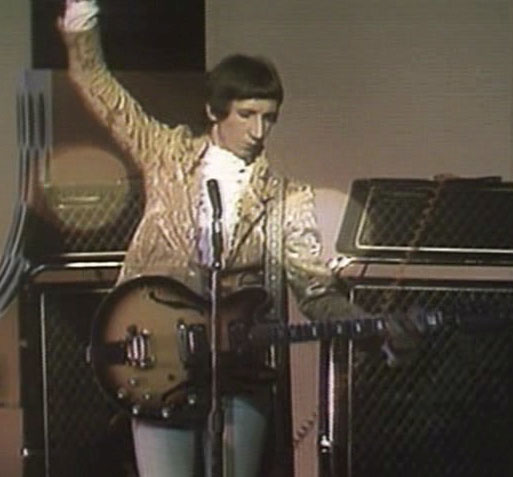
15 Sept. 1967, on the Smothers Brothers show, miming through two short-lived U.S. Thomas Organ (Vox) Super Beatle amplifiers. Note label is taped over. Guitar is 1967 Vox Cheetah.
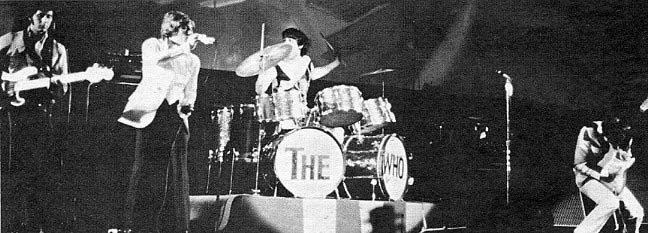
March/April 1967, the first U.S. dates and first use of the Super Beatles: the Murray the K shows in New York, with John and Pete each playing through two Super Beatles. Pete’s guitar is Fender Stratocaster.
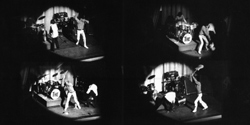
Click to view larger version. March/April 1967, the first U.S. dates and first use of the Super Beatles. Two Super Beatles, with speaker cabs arranged stage left, and two amp heads on separate roller rack, plus Grampian reverb unit for overdrive. Pete’s guitar is Fender Telecaster.
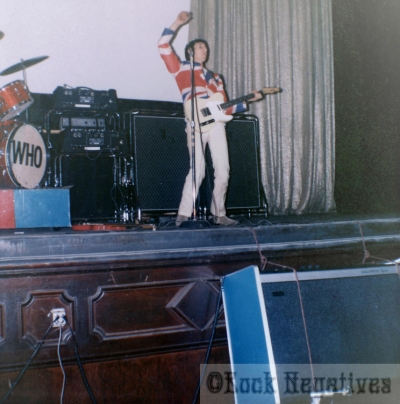
March/April 1967, the first U.S. dates and first use of the Super Beatles. Two Super Beatles, with speaker cabs arranged stage left, and two amp heads on separate roller rack, plus Grampian reverb unit for overdrive. Pete’s guitar is Fender Telecaster, with Fender Stratocaster with rosewood neck as spare in front of drum riser.
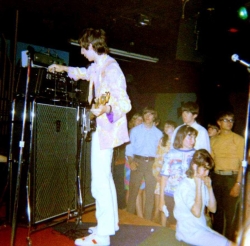
Click to view larger version. 14 June 1967, the Fifth Dimension Club, Ann Arbor, Michigan. Two Super Beatles on roller racks, plus Grampian reverb unit for overdrive. Pete’s guitar is sunburst Fender Stratocaster that would be smashed at Monterey Pop.
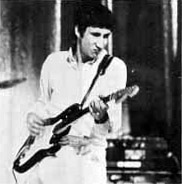
1967
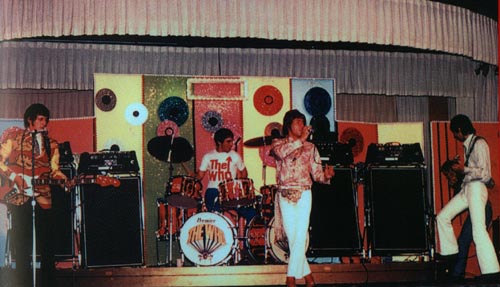
19 July 1967, Salt Lake City, Utah, John and Pete playing through two Super Beatles each, with the tops reversed on the chrome roller rack, presumably for easier control panel access.
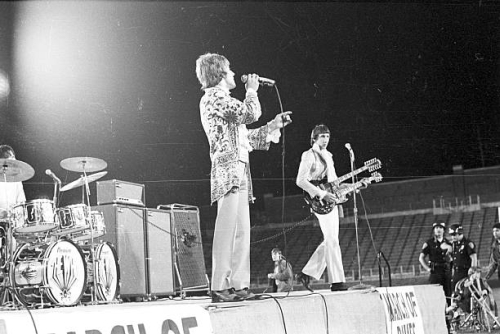
Atwood Stadium, Flint, Michigan, 23 Aug. 1967, with late use of a Super Beatle amp, and earliest known use of the Sunn 100S with two 2×15s, plus Gibson SG EDS-1275 double-neck.
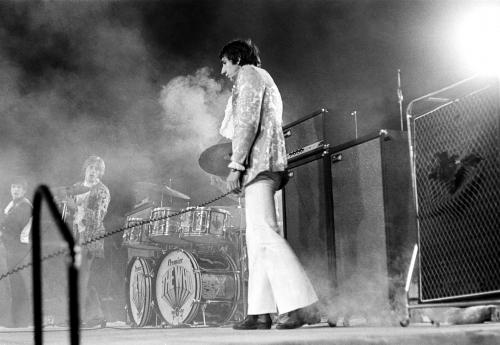
Atwood Stadium, Flint, Michigan, 23 Aug. 1967, with late use of a Super Beatle amp, and earliest known use of the Sunn 100S with two 2×15s.
Vox U.S. Thomas Organ V1143 Super Beatle amp, owned by Brad Rodgers
Brad Rodgers owns the following Vox U.S. Thomas Organ V1143 Super Beatle. It was reportedly left with Murray the K following their shows in spring 1967. Vox Beatle amplifier model V1143, serial no. 1290020, and Vox Beatle Speaker Cabinet, model V4141, serial no. 195274. Images courtesy whocollection.com.
Resources and Information
Vox information
- The Vox Showroom: voxshowroom.com
- Vox U.S. Thomas Organ Super Beatle: voxshowroom.com/us/amp/beat.html



